The Induction Site
Search this site, or just roll your cursor over the colored boxes below the pictures.Advertisement:
Advertisement:
Advertisement:
Advertisement:




"She'd scarcely left a pot or pan
For me to cook a meal in."
—Wilfred William Gibson
Quick page jumps:
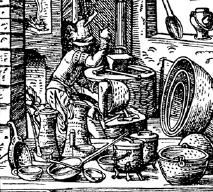
Cookware for use with induction-cooking equipment needs to meet two criteria. First, of course, it must heat up satisfactorily on a present-day induction element (by saying "present-day" we exclude the possible—but, if so, probably years-away—"all-metals" induction equipment). But second, it has to be good cookware, not just "induction cookware".
Let's talk a little about "good cookware" in the general sense; this will only be a brief note, because there are some superb and extensive discussions available on the web, and we will point you at some in a bit; but first, the basics.
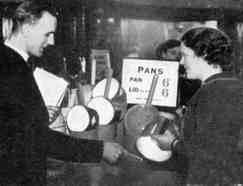
Point number one is that a given piece of cookware is "good" or "bad" only in respect of some particular cooking task. Cookware that is terrible for some cooking tasks can be excellent for others. Consider merely whether we want something that both heats and cools very quickly or something that, if slow to heat, is also slow to cool down? Do we want a vessel with straight, tall sides, or one with low, curved sides? Questions like those are why well-equipped kitchens have a number of variously sized and shaped pots and pans.
While personal opinion and experience must obviously have much to do with deciding what's "essential" cookware, there does seem to be a fair consensus among experienced cooks. As an example, the well-respected magazine Cooks Illustrated, in 2009, set forth in a nice summary form the cookware items that they, with individual and collective decades of experience with professional and serious amateur cooking, felt are the requisites, and they are seven in number.
(This list varies a bit from an earlier one Cooks had assembled; the changes they made were replacing a single 3-quart sauce pan with two sauce pans of 2 and 4 quarts, dropping a 3-quart saucier, dropping a non-stick skillet and instead replacing the ordinary sauté pan with a non-stick version.)
| Name | Looks like | Good size | Material | aka |
|---|---|---|---|---|
| traditional skillet |

|
12 inches | stainless steel | frypan omelet pan |
| cast-iron skillet |

|
12 inches | cast iron | frypan |
| sauté pan |

|
10 inches | anodized; non-stick interior |
(basically a lidded skillet with straight rather than flared sides) |
| sauce pan |

|
2 quarts | stainless steel | --- |
| sauce pan |

|
4 quarts | stainless steel | --- |
| Dutch oven |

|
7 quarts | enamelware | french oven casserole |
| stock pot |

|
large (12-quart) |
stainless steel | --- |
(Cooks also included particular brand/product cookware recommendations, but here we won't get to brands till a little farther on down this page.
It seems safe to say that few would quarrel seriously with that list as a whole, and we will use it as a guide. We should remark that some cooks think a pressure cooker is almost as vital; we're not sure that qualifies as "basic gear", but we mention it.
While the characteristics of a piece of cookware are determined in part by its shape and size, they are mainly determined by what the cookware is made of. Materials for cookware differ in many ways, but the chiefest of those are: the ability—or inability—of that material to readily conduct (and thus evenly distribute) heat; and its "structural" qualities. The cookware materials of common choice are metals: copper, aluminum, iron, and steel, especially "stainless" steel. Serious cooks do not seem much enamored of non-metallic cookware, probably because their heat-conductivity properties are terrible—"hot spots" abound; but what kills them for serious stovetop use is immaterial in oven baking, where the heat floods in from all sides, and it is essential to have a few such things about if one has—and one should—a microwave oven; they can also be useful in ordinary ovens. Clay also is best reserved for oven cooking.
"Steel" is iron with a slight (c. 1%) admixture of carbon, which changes the qualities of the iron. Stainless steel is steel with some chromium alloyed with the steel; if the chromium content is at least 12%, the alloy qualifies as "stainless" steel, but 18% chromium is the norm. Stainless steel can also, and often does, have some nickel mixed in as well; nickel is not essential to steel being "stainless"—though it does add a little further corrosion resistance—and it is chiefly used to enhance the characteristically bright, shiny surface finish of stainless steel (it does also somewhat increase the metal's hardness and temperature tolerance). Stainless steel with the usual 18% chromium but no nickel is referred to as "18/0" stainless (technically, that designation is now outmoded, but most people still use it); if nickel is present as, say, 8% of the alloy, that alloy is designated "18/8" stainless. Top-of-the-line cookware commonly contains 10% nickel, and is thus "18/10" stainless steel. The nickel content is crucial to the suitability of the steel for use with induction, as explained farther below.
There are several nice summaries of the pluses and minuses of cookware uses of the various metals available on line, a few of which are linked a little farther on here. In short, though, any one material alone invariably represents serious tradeoffs between advantageous heat-transfer qualities and disadvantageous structural qualities, or vice-versa. (Steel is strong, but has poor heat transfer; aluminum and especially copper have excellent heat transfer, but are relatively soft.)
Sigh. What a shame that we can't develop a cookware material that shares stainless steel's structural qualities with the heat-related virtues of copper or aluminum. But, if we can't (yet) roll out such a material, we can do what's almost as good: combine those materials in the construction of our cookware. That is accomplished by making cookware that constitutes a "sandwich" with stainless steel on the outsides—as the "bread" of the sandwich—and copper or aluminum between, as the "meat" of the sandwich. We refer to the heat-transfer material, be it copper or—more commonly—aluminum, as being "clad" in stainless. In some fancier constructions, the base is not merely a 3-layer "sandwich", but can have 5 or occasionally as many as 7 layers.
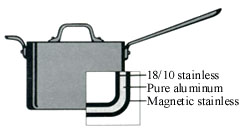
Just as one example, the well-liked All-Clad Stainless Steel cookware line (illustrated at left) can be considered as—depending on how one looks at it—a 3-layer sandwich or a 6-layer sandwich, in that the "middle layer" is in fact three separate layers of heat-distributing aluminum; the inner layer is full 18/10 stainless steel, while the outermost layer is 18/0 magnetizeable stainless steel.
By using clad "sandwiches" of materials to construct cookware, we get most or all of the heat-related virtues of copper or aluminum combined with the structrual advantages of stainless steel. While no one suggests that such cookware is the only satisfactory form—many like pure copper, despite the perpetual grief of keeping it clean and shiny, others like other things—but it is an excellent one that is very widely used by both professional and home chefs.
Incidentally, there is a fairly common belief that for a piece of cookware to be "quality" clad, the cladding must continue from the base on up into the walls of the vessel, and correspondingly that cookware consisting of a clad baseplate with solid stainless-steel walls is something lesser. The truth is—as always—not so simple. While some excellent makes (such as All-Clad) do indeed carry the cladding up the vessel walls, other equally good lines do not. Much depends on the particular vessel: for some purposes (meaning for certain types of vessel meant for those cooking purposes, such as sauce pans) having a vessel wall that is heated augments the functionality; for other purposes, in which having the heat concentrated in the vessel bottom is desired or at least satisfactory, having heated walls may actually just waste some heating energy. Remember that on a gas burner, there are often flames licking up the sides of a cooking vessel, so having cladding in those sides can be important; but with induction, it may be less important (though the wall cladding will still help conduct heat up from the base into the walls). In short, it's a complex topic with no simple answer. (Cook's Illustrated stated that "Our tests have shown that disk-bottom pans often perform just as well as fully clad pans: With some exceptions, the thickness of the core is more important than whether or not it covers the sides of the pan.")
So much for the bare basics. For much more detailed explanations of general cookware considerations, we refer you to these several excellent articles:
Understanding Stovetop Cookware (by Samuel Lloyd Kinsey, at eGullet) [archived copy]
Common Materials of Cookware (by Michael Chu , at the Cooking for Engineers site)
Pan Construction and Cost (from A Cook's Wares) [archived copy]
Cookware & Bakeware (from The Gourmet Retailer magazine) [archived copy]
One other topic worth mention is so-called "non-stick" cookware. Most of it is lined with a layer of PTFE (polytetrafluoroethylene), the best-known brand of which is Teflon®. Concerns have arisen over the health safety of PTFE in cookware; there is no definite answer on the risks, but a great many people are sufficiently concerned that they want an alternative. In a 2006 article in The New York Times, Marian Burros experimented with a number of recommended alternatives to Teflon-coating, and concluded that the clear winner was an enamelled cast-iron pan, followed closely by seasoned cast iron; the brand used was (of course—this was The Times) Le Creuset, but there are notably less-expensive yet at least equally good alternative brands, notably Lodge.
In light of the public's reaction to the purported dangers of Teflon—which are not well-established, but people like to play it safe—a number of new kinds of cookware have emerged to compete with the old standbys, well-seasoned cast iron and enamelled cast iron. Some, like "Thermalon" (as in the "Green Pan" line), have bombed badly with consumers owing to serious durability issues (see this blog for a sample of why). On others—such as titanium pans with special non-Teflon coatings, ceramic-coated pans (also said to be dire as to longevity), and porcelain-covered pans (described by some as somewhat vulnerable to rough handling)—the jury is still out, but no likely winners seem in sight. Best bet? Stick to well-seasoned cast iron.
We know by now that for the present and at least the near future, any cookware to be used on an induction-cooking unit needs to be able to well support a magnetic field in it—that is, to be substantially "ferrous". If you recall a little of either Latin 101 or Chemistry 101, you'll know that "ferrous" refers to a metal that is iron or iron-based. But, though steel is certainly iron-based, in fact not all stainless steel is readily magnetizeable. There is a widespread misunderstanding about that as relates to induction cooking: but, again, merely being made of stainless steel does not make a piece of cookware "induction ready".
First, though, let us say that straight iron, as found in either the classic old cast-iron cookware (especially that old standby, the cast-iron skillet) or in the modern pepped-up stuff coated with bright-colored enamel finishes—in, as Consumer Reports put it, "Crayola colors"—works excellent well on induction. That doesn't necessarily make it a good choice for every cooking use, but we'll come back to that issue.
Because induction cooking is so common in Europe and in professional settings, makers of high-quality cookware—and, in recent years, even of good to average cookware—have taken pains to produce extensive lines of induction-ready cookware. That they do by making sure that one of the layers in the base cladding "sandwich" is a readily magnetized metal of sufficient thickness to readily absorb the available electromagnetic energy and convert it to heat. So rapidly is induction emerging that even makers of completely non-metallic cookware are taking to putting a, 18/0 stainless-steel 'slug" on the bottoms of their cookware so that it will work on induction—and look for more moves like that.
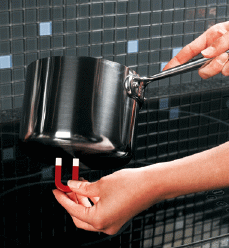
Regrettably, there is no simple way to know if this or that line, or particular piece, of cookware is really induction-ready, unless you have the opportunity to actually handle it. In that case, all you need is a simple magnet of any kind—say one of those decorative toys meant to be stuck onto refrigerator doors. If such a magnet readily clings to the base of the cookware piece, that piece is induction-ready; if the magnet does not cling, or clings only very weakly, the piece is not. But if you are buying "remotely", such as online, you cannot perform that test. (Well, maybe you could visit a local retailer to try it, then buy remotely.) If you cannot perform the test yourself, you are obliged to rely on the cookware maker's or retailer's supplied information. That is not, in the real world, much of a problem, in that most cookware makers are pround of their gear's induction readiness, and will tout it clearly. So take this as a warning:

In the modern world, cast iron seems in some danger of being too commonly overlooked, perhaps seen as an "old-fashioned" novelty or specialty sort of cookware. It is not. About the only things that don't cook best of all on or in cast iron are those where the cooking process requires a rapid change of temperature. Cast iron is the original (and still the best) "non-stick" cookware: a properly seasoned piece of cast iron cookware is silken smooth, and everything from pancakes to flatbreads cooks wonderful well—and easily—on it.
(There is an informative article, "Heavy Metal: the Science of Cast Iron Cooking" [archived copy], by Dave Arnold, at the French Culinary Institute blog.)
The brand choice here is a true no-brainer: Lodge is so far ahead, it's hard to know if there's even a pack to be ahead of. (In the special category of enamelled cast-iron cookware, there is at one extreme the very high-priced Le Creuset brand and at the other numerous no-name imported knockoffs; but even here—or, considering price and quality, perhaps especially here—Lodge also shines bright.)

Having easily reached that conclusion, we are now retailing Lodge cookware on this site. As with actual induction-cooking equipment, we believe we have the lowest prices to be found on the web, and we invite you to look over (and, we hope, select from) the entire Lodge line of cast-iron and enamelled cookware.
We get asked a lot about using cast-iron cooking vessels on the ceramic-glass surface that all induction-cooking units use: does it scratch? Can one cook using "pan-slide" techniques without scratching the surface? Lodge cautions that their non-enamel cast-iron cookware (and this would likely apply to all cast-iron cookware except, of course, enamelled cast iron) might cause scratching, as the bottom of a cast-iron piece is naturally rougher or grittier than, say, stainless steel, and anecdotal evidence strongly supports the realistic possibility of such scratching. But . . . this is induction—no flames! We thus need to think outside the box. If you have a cast-iron skillet and want to cook something using the pan-slide method, just put a sheet of some heat-resistant (and non-metallic) substance under it. The obvious choice is parchment paper; though one maker (Reynolds) says it can be used "at temperatures up to 420°F", Cook's Illustrated refers to its being "enormously resistant to high temperatures"; many widely published recipes using parchment paper call for baking at 450°F and we've even seen pizza recipes calling for parchment paper in an over at 500°F to 550°F. All in all, it seems unlikely that the temperature of a skillet bottom would be a problem for parchment paper (and its silicon coating makes it slick and so, presumably, easy to slide a pan on). While we haven't yet had opportunity to test it ourselves, we feel confident it would work fine in this use. Parchment paper is relatively inexpensive—only a tad more than ordinary waxed paper—and universally available (and is a handy thing to have in a kitchen anyway); Cook's likes the Reynolds brand.
(The "autoignition temperature" of a substance is the lowest temperature at which it will spontaneously combust in a normal atmosphere without an external source of ignition, such as a flame. The autoignition temperature of even ordinary paper is—despite author Ray Bradbury's immortalization of the title Fahrenheit 451—actually 450° Celsius, which is about 840 °Fahrenheit—so parchment paper ought to fill the bill here just fine.)
There is also an almost comically simple alternative for a more permanent fix. It's one of those ideas like the safety pin or the paper clip: blindingly obvious in hindsight, but not apparent at once. Just sandpaper the pan or pot bottom smooth! Readers have reported to us that they have done just that, with excellent results. We don't have details, but we'd guess that two grades of sandpaper, a coarse then a fine for polishing off, would do the job. (If you've done this, please email us with exactly how you did it.)
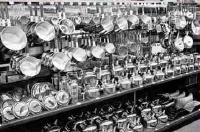
When we first began work on this page, we started making a list of known induction-ready clad cookware lines—but we quickly abandoned that effort, because the list was becoming comically and tediously long, yet would obviously still be far from all-inclusive. We instead decided to go at it the other way round: identify excellent cookware, then see what's induction-ready.
That still did not make the task simple. The world is full of cookware of undoubted excellence, and to abstract from that fullness a few particular brands necessarily requires some harsh and perhaps arbitrary chopping. We're not in a position to ourselves relentlessly test brand after brand of cookware, so we necessarily have to rely on what other say; that, in turn, requires not only extensive reading, but also the judging of the probable expertise or reliability of the sources being consulted. Here are some of the places we looked, and what they had to say.
One useful resource, Consumer Search's Cookware review, does just what we were engaged in doing, "meta-reviewing": it's a review of cookware reviews, so to speak. You can (and should) check their material for yourself, but two things emerged clearly from it: the overwhelming majority of review sources went for stainless-steel cookware, and of stainless, the runaway preference was the All-Clad Stainless Steel Uncoated cookware line. There are less-expensive alternatives discussed, but as the review says "[P]rofessional chefs, expert cookware reviewers and amateur foodies agree that you should always have the best tools you can afford. So, if you can afford All-Clad, you should get it and then pass it along to your children."
In December of 2005, the Consumer's Union organ Consumer Reports published its take on cookware (available on line only to paying members). Their methods and criteria may not match those of expert cooks, as they address the general consumer market, nor did they include every line of even just the better-known cookware names (some of which are "well known" only in narrower culinary fields). Their winner for uncoated cookware was the Kitchenaid Gourmet Essentials line. All-Clad was a ways down their list, though the separation between brands, even top to bottom, doesn't look vast (they use little bars to signify). Calphalon Contemporary, another popular line, was their runner-up to the Kitchenaid; that is interesting, because Cook's Illustrated found Calphalon less than satisfactory (see the Consumer Search metareview linked just above). So the significant discrepancies between Consumer Reports and most cooking-specialist reviews seems to cast some doubt on the utility of a general-purpose consumer magazine for reviewing specialty items. But you can read it for yourself (if you subscribe).
Another source is an AP article Cookware 101: the essentials [archived copy], which discusses the types of items, but not much about brands; perhaps the most notable sentence in it is one germane to the paragraph above: But Consumer Reports' findings don't jibe with those who spend their days in the kitchen. Take it for what you feel it's worth, but that does seem to be expert consensus.
The classic Cook's Illustrated list, A Guide to Essential Cookware, set forth different cookware makers for their recommended basic "set", item by item; their stainless choices were each from All-Clad, the exceptions being the stockpot and the non-stick sauté pan. Interestingly, for a stockpot they recommended the cheapest thing not actually trash that you could find, inasmuch as all they recommend using it for is boiling large amounts of water, as for pasta; for true stock-making, they prefer a Dutch (aka French) oven—and we think that is indeed a sound idea.
Our own conclusions, after reviewing those sources—and quite a number of others—is that when push comes to shove, All-Clad is the winner. It's not so much that this or that more or less qualified authority praises it, it's the cumulative weight of one after another after another after another, all in glowing superlatives. It's not so much that nothing else is really any good—as we said, there's lots of good cookware—it's that apparently nothing else is quite this good.
(But, again, note carefully that this refers only to All-Clad's "Stainless" line, actually so named: they have other lines, some made of stainless steel, that are not induction-suitable—so make sure you're looking at the correct product line; noteworthy is that their "Copper Core" line is now also induction-ready—as we keep saying, more and more makers, in more and more of their lines, are taking steps to keep up with the induction revolution.)

All-Clad is not inexpensive. (Though as one cooking-school chef said, When it came time to upgrade from the Calphalon Commercial Nonstick set that I have at home, I considered All-Clad, Mauviel Professional and Demeyere Sirocco. I chose All-Clad because it is good and inexpensive compared to other cookware in its class. [emphasis added] You don't always get what you pay for, but you never get what you don't pay for. If your idea of cookery is centered on microwaves and Hamburger Helper, you don't need or want All-Clad; if you take cooking in the least seriously, then consider that you're buying cookware that you can, with only modest care, pass down to your descendants. What is its cost when amortized over its useful lifetime? Not a major factor.
And no one says you have to buy every scrap of cookware you'll ever want all in one swoop—if budget is a consideration, add pieces over time, making do with whatever (though Lodge cast-iron is awfully good "whatever") till you can get The Real Thing. Indeed, we—along with most sources we checked—recommend that you stay away from "sets", in which you too often get items you don't very much need or want—and stick to building your enduring cookware collection item by item, as budget allows and need suggests. And, again, keep in mind that cast iron, which is pretty inexpensive, can be the backbone of a good collection.
Having reached that conclusion, we are now retailing the All-Clad "Stainless" cookware line on this site. As with actual induction-cooking equipment, we believe we have the lowest prices to be found on the web, and we invite you to look over (and, we hope, select from) the All-Clad induction-ready lines of stainless-steel cookware (three: the classic "Stainless", and now the "d5", and "Copper Core" lines).
(But we will continue to research, and perhaps eventually add, other lines of clad cookware.)
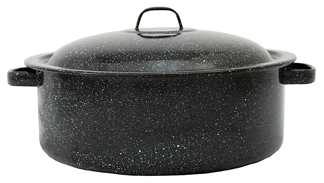
This sort of cookware is generally known as "graniteware" (though also sometimes as "agateware"), and it dates back almost two centuries. It is generally similar to enamelware (and indeed could be considered a subset of enamelware), but nowadays the coating is applied over steel rather than cast iron. The name comes from the distinctive white-mottled appearance (see the image at the right), which gives the look of granite (or, in some eyes, agate).
Graniteware can, in principle, come in any color, but to get yellow, red, and certain other bright colors it is common to use cadmium, which is potentially hazardous to at least the workers who make the goods; that is why most graniteware is blue or black (with, again, that characteristic white mottling).
Graniteware is today made chiefly (or wholly?) by one company, Columbian Home Products. The product line is well suited for use on induction: the core is 98% iron, while the porcelain (or glass) surface is fused to the steel at 1800 degrees; that surface is inert so it won't interact with or change the flavor of food, and the exterior is glass-smooth so it won't scratch the glass top of the induction cooktop as raw cast iron might.
A couple of noteworthy advantages of Graniteware are that it is dishwasher-safe, and that it is relatively light in weight. Lightness can mean that the bottom is a bit less able to hold steady temperatures, but in our personal experience that has not been a problem; but, being lighter, the cooking vessels are a lot easier to handle and carry, which can be important for those with relatively weak hands or arms. Moreover, Graniteware is relatively inexpensive, and widely available. Finally, the items look rather pretty. (And, for those to whom such things matter, the goods are all manufactured in the U.S.A.)
Full disclosure: we were sent test samples of a few items of CHS Graniteware.
The CHS Graniteware line is chiefly pots and pans, though it also includes stockpots, steamers, double boilers, home canners, and other special-purpose cookware; if you follow the link in the paragraph above, you can see it all on the maker's web site. We expect that we will soon be adding in to our lists of cookware we sell.
Advertisement:
Advertisement:
All content copyright © 2002 - 2025 by The Owlcroft Company.
This web page is strictly compliant with the W3C (World Wide Web Consortium) Extensible HyperText Markup Language (XHTML) Protocol v1.0 (Transitional) and the W3C Cascading Style Sheets (CSS) Protocol v3 — because we care about interoperability. Click on the logos below to test us!
This page was last modified on Monday, 22 January 2024, at 12:46 am Pacific Time.